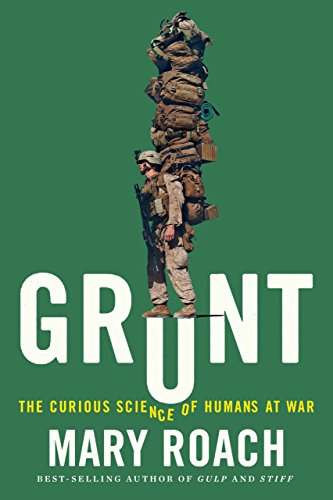
There’s something seriously wrong with Mary Roach. Conjure up any vile, disgusting, or taboo subject that anyone in her right mind would shun — and you’ll find Mary Roach has written a book about it (or is probably planning to do so). Her books to date have dealt with cadavers, the afterlife, surviving interplanetary flight, the physics and chemistry of sex, and the human digestive (and excretive) tract. And she is not inclined to use circumlocutions. She calls crap crap. I love this woman!
Military science under the microscope
Now, in Grunt, her latest book, Roach has turned her attention to military science, specifically the science-based efforts by the U.S. defense establishment to clothe, train, armor, and heal our soldiers, sailors, and airmen and protect them from every manner of wound and loss of function. Unfamiliar and uncomfortable topics such as battlefield hearing loss, shark repellent, bird strikes on airplanes, diarrhea, and penis implantation figure in the story. (The only major topic she avoids is PTSD, because, she writes, “it has had so much [coverage], and so much of it is so very good.”)
Grunt: The Curious Science of Humans at War by Mary Roach ★★★★★
Roach tells her tale with brutal honesty — and leavens it with an abundance of humor. Some passages are laugh-out-loud funny. Maybe what’s wrong with Mary Roach is that her sense of humor is so much better developed than it is in the rest of us. In any case, I love what she writes.
Surprises galore
Unless you are remarkably knowledgeable about the U.S. military, you’re likely to learn a great deal about how it actually works by reading Grunt.
- Consider, for example, the years-long investigation carried out by the Bird Aircraft Strike Hazard (BASH) team of the United States Air Force. You’ll learn why shooting chickens out of a sixty-foot “chicken gun” at 400 miles per hour to test their impact on aircraft in flight was eventually deemed unsuitable. The scientists shifted to turkey vultures. As Roach informs us, “Though implicated in only 1 percent of Air Force birdstrikes, the weighty raptors are, by one accounting, responsible for 40 percent of the damage.” Serious people actually spent years figuring all this out!
- You’ll learn why the Army’s clothing designers crafted custom-designed tops for snipers, with pockets on the sleeves for easy access, a zipper on the side instead of the front, and no buttons, so that when lying on the ground or crawling across it their buttons won’t catch or the zipper make noise that might give away their position. (FYI, “US government button specifications run to twenty-two pages. This fact on its own yields a sense of what it is like to design garments for the Army.”) Can you imagine any army, anywhere else in the world, that would go to such lengths to outfit its troops?
- “In a place like Afghanistan,” Roach writes, “sweat keeps more people alive than corpsmen do.” The explanation (in Chapter 7) is fascinating.
You get the point. Military science can be fun — at least, reading about it can.
About the author
Mary Roach has written eight books of science journalism. Her work has garnered several awards and been shortlisted for many more. Her books have been bestsellers from the start, beginning with her first effort, Stiff: The Curious Lives of Human Cadavers.
For related reading
You might also enjoy Science explained in 10 excellent popular books.
If you enjoy reading nonfiction in general, you might also enjoy:
- Great biographies I’ve reviewed: my 10 favorites
- My 10 favorite books about business history
- 20 top nonfiction books about history
And you can always find my most popular reviews, and the most recent ones, on the Home Page.



























